Before I start to tell you about tools, I want you to know that I have been working on quilt projects that have been stacking up on me for years. The one I have done the most on is a quilt that goes back at least ten years. It is a scrap quilt that was a Guild project. It left me with ten blocks that need to be assembled and finished with an applique border that has vines, flowers and leaves all around nine of the ten blocks. (I had one extra block). Then two more borders around that. I have now fused all the pieces on the border and I still need to do a zig-zag stitch around all of the flowers, leaves and vines. That’s the time consuming part. I also finished the last block of an applique quilt that is called Blue Willow. It’s almost a full size quilt that was designed from the Blue Willow design dishes. I now have to put the blocks together with sashing*. It is all in shades of blue with a white background. I’ll post it when it’s put together. I’ve also done some ME. I successfully stitches t-shirts for my grand daughters. One with a French Horn and One with a Saxophone. I hope they’ll like them. I did a piece of free standing lace and a piece of cutwork that didn’t turn out so good. (My mistake—Drats!*) Just to whet your appetite for quilts, I’m including a picture of one of my quilts.
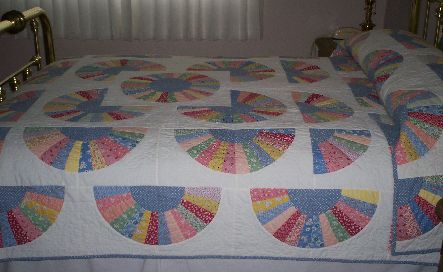
Tools:
In a
previous post, I talked extensively about
Rotary Cutters (RC) and Freezer paper (FP), but there are so many other quilting tools that are available. Some are needed right at first, and some, like freezer paper, are things that will not be needed at first or may not be needed at all, depending on what kinds of quilting you decide to do. Since some of you are just beginning or are fairly new to quilting, I will talk about basic tools. Then, I may go on to others when the need arises. Please, ask questions about anything that puzzles you or something you may think I have left out. I want to say again that I'm not an expert, just a lucky person who knows something about quilting and because of that was asked to write this blog.
Many of the basic tools are usable for all types of sewing, and household use. Purchase quality tools the first time and they will last much longer than the cheap ones that come in sewing kits. Sewing kits are OK for people who don't sew anything but buttons. But if you plan to use these tools often, don't go for a packaged sewing kit.
First of all, the very most basic tool is a box or sewing kit of some kind. I suggest it be a box with a handle. You may decide to take some classes, and you'll need something to take along that is easy to carry. Make it big enough to carry plenty, but small enough that it's not too heavy when it's loaded. I've had a bunch of different boxes. The best ones are the ones that have a handle and some kind of locking mechanism so that will stay closed when carrying. I especially like one that I found at "my local discount department store." It is about 9" X 14" and 6" deep. It has a blue lid that locks on top with a gray plastic clamp on each side. It also comes in a smaller size. I have several of those that I use for other things as well. Another box that I like a lot can be found mostly at hobby stores. It is a larger plastic box that has smaller square plastic boxes about 8" x 8" that fit nicely inside. It holds about eight of the smaller boxes that are sold separately. This box was invaluable to me when we lived in our motor home for six months while we built our house. It was big enough to hold nearly all of my sewing tools, not just quilting supplies. But it got pretty heavy when it was loaded.
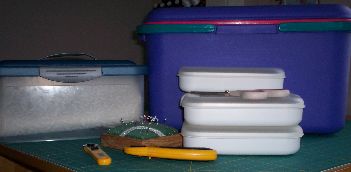
Pens, pencils and markers
are also basic. There are so many that it's hard to describe them. But I suggest first a mechanical pencil, and at least one disappearing marking pen. There is special lead for quilters that fits a .5 mm mechanical pencil, available at some quilt shops. It is marketed to wash out better than other pencil lead. I also suggest that you select your own style of mechanical pencil, since there are varying quality and styles. Next, get a good White pencil eraser. They also come in many shapes and sizes, but there is one with a plastic, mechanical case, that keeps the eraser clean and ready to go for a long time. A number two pencil is handy, but keep a good sharpener at hand. Electric, battery operated sharpeners have gotten much smaller and cheaper than they once were. They even make them small enough to go in your sewing box. Permanent markers may also be needed, but be sure you know that you want the marks permanent, because they will stay. They are good for marking templates, supplies, etc. In this photo are, a measuring tape, mechanical pencil, white pencil-type eraser, water soluble markers, white chalk pencil, permanent marker and seam ripper. Behind are a #2 pencil and small battery operated pencil sharpener.

A good dressmaker's cloth measuring tape is a must. I have several retractable ones. They don't cost a lot more, and are much easier to use. Get one that is 120 inches long. Bed size quilts are always more than the 60 inch size dressmakers tape.
Most of you already have an iron and ironing board. I know that all of you who read this blog are so "into" ME that the only clothes you own are permanent press or knits. But you will need to dust off that old iron and board. I have a really good steam iron that I've had for over fifteen years. It is a quality brand that is often marketed to quilters. Before I got this iron, my irons didn't last more than a year or two. Last year, I had trouble with it not heating. My husband replaced the plug and it's been great since. Greg says that the perfect irons will soon be available in the AnnTheGran shop.
Hand sewing Needles:
This is a wide-open subject. I have found that when I purchase needles any place but a sewing or quilting store that the sizes vary a whole lot. I still have needles that I bought before I discovered this. (I need to throw them away.) I have found that the same size needle is much smaller and finer when I buy a brand that is marked for seamstresses and quilters. Good brands are John James, Peacemakers, S. Thomas, Roxanne. Two kinds of needles are used for quilting. Hand quilting needles are called betweens, or quilting needles. Sharps are all purpose needles that are used of applique and hand piecing. Both kinds are sized by number, the higher the number, the shorter the needle. It's probably a good idea to buy an assorted package so that you can try them out to see what size is best for you.
Pins & pincushions
Use long, thin, dressmakers’ pins that are rust proof for piecing and applique. I really like glass headed pens, so that I can see them. There are so many kinds of pincushions that I'd say it's is probably user's choice. I have one that was given to me that I really love. It is a home made wooden box, about four inches square, with a thin wood bottom. It is about one inch deep. The pincushion itself is made from fabric squares, sewn to fit the box. It is filled with silica sand, which is very good to keep pins and needles sharp. It is quite heavy, so it stays put wherever you set it down. I have heard pros and cons about using magnetic pincushions near electronic sewing machines. I have read that they are OK and also that you shouldn't use them at all. I just say, use magnets with caution, or check with your sewing machine dealer to see if it's OK for your machine. Pincushion and magnet are shown in this photo.I am not an expert in this subject. I usually have trouble deciding which needle to use for which project. Check with you machine manual or any other source that can enlighten you.
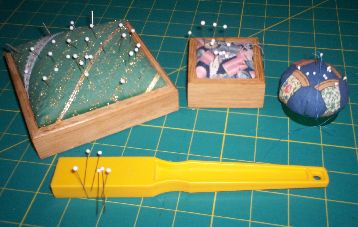
I do have two magnets that I keep near the chair where I do hand work and one in my sewing machine cabinet. It is one of my handiest tools. I have seen it in many notions departments. It will certainly find those stray pins and needles in the chair cushions and carpet. I have given them as gifts, and they are always appreciated. Especially the 90-year-old lady that I gave one to. She was really happy to be able to find those stray pins and needles while she quilted her Baltimore Album quilts.
Rotary cutters:
I have talked a length about the RC, but I want to add a few points. I have said that a RC is dangerous, but even more dangerous is a dull blade. When the blade has been used a lot, and becomes dull or skips a few threads, it takes more effort to cut through layers of fabric. So, we give it a little extra muscle and it's easy to slip with the extra pressure. Change those blades if they become harder to use. Blades seem expensive, but an Emergency Room trip costs a lot more than a new blade. Check the prices of multi packs of blades. They get cheaper, the more there are in a pack. If you find larger packages, split the cost with a friend, but make sure you buy a quality brand.
Cutting mats
I have many mats, from a small one to take to a class to the large ones that top my cutting table. Choose cutting mats that are heavy duty, with ruled lines. To keep you mats in good shape, treat them with loving care. Always keep them flat, never roll them. Mats are subject to warping easily. I have stored mats between the mattress and box springs of a bed. Heat is an enemy to cutting mats. Please don't forget them in the trunk of your car. Don’t stand them on the edge. They will warp. They are pretty sturdy, but they can crack on the edge and warp on the corner, but they will last for years if you keep in mind that they cost more to replace, than to purchase the first time. Like everything else, the prices rise.
Rulers
They come in loads of sizes and shapes. Begin with a 6" x 12" or 6" x 24", then choose a few more, depending on what kind of quilting you are doing, and your personal preference. I like the ones that are clear with frosted dots on the back that help grip the fabric and keep it from slipping. Make sure that they have angle lines on them. With a 45 and 60-degree angle line on the ruler, you may not have to buy a specialty ruler, cut with those angles.
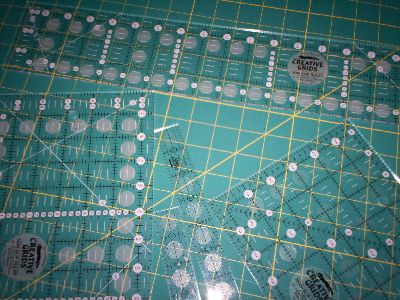
Seam ripper
We all need at least one of those so we can do the "frog stitch"
"Rip-it, Rip-it!" Get one that has a small fine tip so you can get into those little stitches. A good one is pictured with pencils.
Scissors
I have a bunch of those. Some of them are pictured. You will need a good pair of dressmaker shears. As scissors go, these are the ones you really need to choose carefully. If they don’t fit your hand, whether they are expensive or cheap, you won’t like them. The most expensive pair I’ve had, hurt my hand when I used them. Luckily, I found someone at quilt guild who was willing to buy them from me. There are so many other kinds that you just have to choose for yourselves the best ones for you and the jobs you use them for. Keep a sharp pair just for cutting paper and plastic templates etc. Keep your good ones for fabric only.

As time goes on, you fill find the need for template plastic. It also comes in a wide variety. Just get some that you can cut easily with scissors. It may take a few tries to find what you like best.
THIMBLE
Here's a topic to quibble about... "I just can't use one." "They don't fit my finger." "Which one's the best?" I have a collection, (literally) of thimbles. But the ones that I use are some of the cheapest available. I can find at least one (or four) any place in the house that I sew. They are simple metal thimbles, with dimples.
I've tried many, even the expensive, silver ones, but I like the cheap ones best for hand quilting and applique.
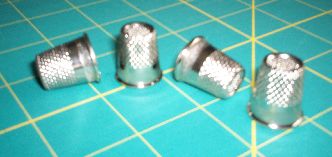
Hoops and frames: I personally use 14 inch round hoop that is made of solid cherry wood. It has a slot around the edge that is just the right size for a Bungee cord to fit, holding the quilt taut on the hoop. The bungee cord can be adjusted to make the quilt tighter or looser for your ease of quilting. I also use the Q-snap frame. It is a plastic, tubular, square frame that is made in sizes for lap quilting and also a larger floor size frames. There are also other kinds of hoops for lap quilting, but choose carefully, as some of the round or oval wooden frames can be flimsy, and hard to manage for quilting. You need a hoop that is sturdy enough to handle the weight of the quilt, if you decide to do a bed size by hand.
Threads
Here again, the variety of threads available is endless. Most people who quilt feel that 100% cotton thread is best. Since polyester thread is stronger than cotton, it's easy to see that when used to piece a quilt, the stronger, polyester threads can cut the fabric fibers at the seam line, leaving a very difficult to repair tear in the fabric. Size 50 cotton thread is best for machine piecing, while Cotton thread labeled "quilting thread" is used for quilting the layers together. However, I like to use quilting thread for hand piecing because it is stiffer than regular sewing thread and it tends to twist less than size 50 thread. I use a very fine, size 60 cotton thread for applique. I have tried both cotton and silk threads for applique and like the cotton better. Cotton thread seems to sit "down" in the fibers of the applique pieces, while the silk, also very fine, seems to let the applique pieces "float" very slightly, not holding the fabric down on the background fabric.
There are many more tools that you may learn to love. I have shared with you some of the ones that I find to be basic to the art of quilting. As you gain experience, you will learn the tools that work best for you. There is always something new coming along. Some of them are great and others you wonder "What crazy person thought of this silly thing, and why the heck did I spend money on it?" Lots of tools are so specialized that you only use them once and then they just lay around and get in your way. Keep in mind that there are lots of people who are trying to make a lot of money. They dream up ideas for new tools and market them to quilters. Some are worth while, some are not. I try very hard not to buy a tool unless I can see that it will be worthwhile to me. Choose wisely and love and care for the tools you use.
Stitches to you,
LaRue
Quilters Jargon:
Sashing - The long straight pieces of fabric that are sewn between the blocks, separating them and making the quilt larger. Can be done in various ways.
Drats - a nicer word than a cuss word that some quilters (me) use.
frog stitch - "Rip-it, Rip-it! Frog stitch refers to taking out the stitches when you make a mistake. "Rip-it, Rip-it"